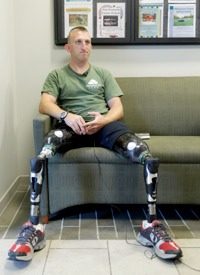
“Hundreds of thousands of the nation’s war wounded from World War I to today have received treatment at Walter Reed, including 18,000 troops who served in Iraq and Afghanistan,” reported the Associated Press. “President Dwight Eisenhower died there. So did Gens. John J. Pershing and Douglas MacArthur. It’s where countless celebrities, from Bob Hope to quarterback Tom Brady, have stopped to show their respect to the wounded.”
The hospital suffered a serious scandal in 2007, when it was revealed that some patients were being neglected and receiving substandard treatment in facilities that were both filthy and in need of repair. But the move to close Walter Reed actually began two years earlier when a government commission made the decision to shutter the hospital, consolidating its operations with Bethesda Naval hospital and another facility in Fort Belvoir, Virginia, to cut operating costs.
“This is the largest medical restructuring ever undertaken in the military health care system,” said Vice Admiral John Mateczun, commander of military medical facilities in the D.C. area. “We have 9,400 people that are involved in the moves in those three hospitals.”
The restructured facility, located in Bethesda, to be named the Walter Reed National Military Medical Center, “will have 345 beds, as well as space for 50 patients in intensive care units and 20 operating rooms,” reported AFP News, while the hospital at Fort Belvoir “will host 120 beds, 10 beds for ICU patients and 10 operating rooms.”
Mateczun said that the estimated $2.6 billion cost of the move was twice the original estimate made by the Base Realignment and Closing Commission (BRAC) in 2005. “All the BRAC estimates were around a billion dollars,” he said. “There certainly have been adjustments since then.”
He said rising costs of materials, as well as the changes prompted by the revelations of substandard patient care at Walter Reed, contributed to the budget overage. Nonetheless, “We got the funding we needed, the care of those wounded, ill, and injured coming back [from combat] being the highest priority next to the war itself.”
Mateczun noted that during the summer months, when the military’s combat operations are at their peak in the Middle East, approximtely 20 U.S. soldiers are evacuated from Iraq and Afghanistan to Walter Reed each week.
Chuck Dasey, a spokesman for the hospital, told Reuters News that the closing “marks a transition to the next stage in the life of Walter Reed. The name will continue on to represent the new flagship of military medicine.”
Colonel Norvell Coots, commander of Walter Reed Health Care System, noted that for many of the hospital’s longtime staff, the closing of Walter Reed would be “like losing your favorite uncle.”
The same goes for many of the countless patients and their loved ones who have walked the halls of the historic hospital. Susan Eisenhower recalled visiting her grandfather, President Dwight Eisenhower, in a special suite at the hospital, where he stayed in 1969 during the last several months of his life. “Frankly, I will say it’s with a heavy heart that Walter Reed closes,” she told AP News. “I don’t know. I know that there was a process for that decision, but we’ve lost a great, important part of history.”
John Pierce, historian for the Walter Reed Society, noted that the hospital’s campus is filled with nostalgia and history, recalling, for instance, that nurses serving there during the Vietnam War married their patients in the rose garden, or that after taking office, President Truman attended church in the hospital’s memorial chapel and visited famed World War I General John Pershing, who lived in a private suite at the hospital.
Pierce said that among those who died at the hospital was President Calvin Coolidge’s teenage son, who succumbed to an infected blister he got playing tennis at the White House.
Pierce also pointed out a fading black and white photo from 1960 showing Senator Lyndon Johnson, then on the presidential ticket with John F. Kennedy, visiting the bedside of Eisenhower’s Vice President, Richard Nixon, who was being treated for a staph infection.
The medical facility was named in honor of Major Walter Reed, an Army physician who treated both soldiers and civilians on America’s frontier, Pierce said. Reed died in 1902 at age 51 from complications of appendicitis, and the colleague and friend who treated him, Lieutenant Colonel William Borden, would go on to campaign for a hospital named in his friend’s honor. “I’m sure [Borden] felt very guilty about that, and over the course of the next several years, he campaigned to get money for a new hospital and of course, wanted to name it for his good friend Walter Reed,” Pierce said.
The original facility had around 80 beds, “but in-patient capacity grew by the thousands during the wars of the last century,” reported ABC’s Washington, D.C. News affiliate WJLA. “Today, it treats about 775,000 outpatients annually, and has an inpatient load of about 150. It wasn’t just service members and military retirees treated at the hospital over the decades, but their families, too. Countless babies were born at the hospital into the 1990s.”
In a retrospective on Walter Reed, Pierce wrote that its patients throughout the years “have included presidents, vice presidents, cabinet secretaries, senators, congressmen, federal judges, generals and high-ranking officers of all grades, Medal of Honor recipients, former prisoners of war, sergeant majors and foreign heads of state.” However, he emphasized, “None have been more important than the lowest ranking wounded warrior.”
Pierce said that to “those who have shed their blood in defense of America and its ideals, a special respect is due: respect and honor for their deeds, sacrifice and courageous examples in overcoming often grievous wounds, and a duty to provide the best and most comprehensive care available, to give them the best chance possible to return to full function.”
Photo: AP Images



